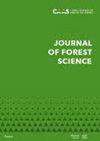Assessment of the Ellenberg quotient as a practical tool for vertical vegetation zonation
IF 1.1
Q3 FORESTRY
引用次数: 0
Abstract
: The Ellenberg quotient ( EQ ) is a climate index defined as a ratio of the hottest month's temperature and the average annual precipitation sum. The quotient indirectly expresses the relationship between climate and vegetation, and its application is related to the ecological niche of Fagus sp. Although the quotient was curated on the grounds of field research primarily on German vegetation, the possibilities of its utilisation are not limited to the Central European region. The objective of this study is ( i ) to compare the EQ values calculated for the forest vegetation zones in the Czech Republic with the published data using the ecological niche of Fagus sylvatica ; and ( ii ) to compare the new EQ -based vertical model with field empirical mapping. The study area is the Czech Republic, Central Europe. We used climate data from 1970–2000 and the data of the National Forest Inventory, 2 nd cycle (2011–2015), representing an ob-jective data design. Geospatial analytic methods, machine learning (boosting), and verification through statistical testing were performed. The results indicate higher EQ values between the two most substantial spatial frames – the Hercynicum and Carpaticum regions. By comparing empirical mapped units to their climatic potential (in the EQ ), a match was found only within the Carpaticum region. The study presents a concretisation of the general climate index for a specific region, adds to the knowledge about the Fagus ecological niche in context with the Central European vegetation, and also points to the EQ 's potential for evaluating the concept of vertical differentiation of forest communities, as well as a possible prediction tool for the vegetation migration in context with climate change.作为垂直植被分带实用工具的埃伦伯格商评价
:埃伦伯格商(EQ)是一个气候指数,定义为最热月份的温度与年平均降水量之比。商数间接表达了气候和植被之间的关系,其应用与Fagus sp.的生态位有关。尽管商数主要是在德国植被的实地研究基础上编制的,但其利用的可能性并不局限于中欧地区。本研究的目的是:(1)比较捷克共和国森林植被带的EQ值与利用Fagus sylvatica生态位的公开数据;(ii)将新的基于EQ的垂直模型与现场经验映射进行比较。研究区域为中欧的捷克共和国。我们使用了1970-2000年的气候数据和国家森林清查第二周期(2011-2015)的数据,代表了客观的数据设计。地理空间分析方法,机器学习(增强),并通过统计测试进行验证。结果表明,两个最重要的空间框架- her愤世嫉俗和Carpaticum区域之间的EQ值较高。通过将经验映射单元与其气候潜力(在EQ中)进行比较,只在Carpaticum地区发现了匹配。该研究提出了一个特定地区的一般气候指数的具体化,增加了关于Fagus生态位在中欧植被背景下的知识,也指出了EQ在评估森林群落垂直分异概念方面的潜力,以及在气候变化背景下植被迁移的可能预测工具。
本文章由计算机程序翻译,如有差异,请以英文原文为准。
求助全文
约1分钟内获得全文
求助全文
来源期刊

Journal of forest science
Forestry-
CiteScore
2.30
自引率
9.10%
发文量
48
审稿时长
6 weeks
期刊介绍:
Original results of basic and applied research from all fields of forestry related to European forest ecosystems and their functions including those in the landscape and wood production chain are published in original scientific papers, short communications and review articles. Papers are published in English
 求助内容:
求助内容: 应助结果提醒方式:
应助结果提醒方式:


